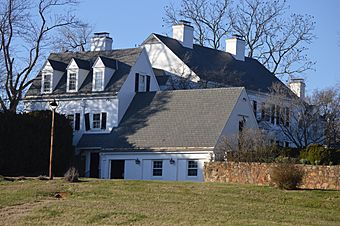Pantops Farm facts for kids
Quick facts for kids |
|
|
Pantops Farm
|
|

Southern side and front
|
|
| Location | 400 Peter Jefferson Road, Charlottesville, Virginia |
|---|---|
| Area | 4.5 acres (1.8 ha) |
| Built | 1937 |
| Architect | Benjamin Charles Baker |
| NRHP reference No. | 05000483 |
| Added to NRHP | May 7, 2014 |
Pantops Farm is a historic house located near Charlottesville, Virginia. It's a special place with a main house, a guest house, and a building that looks like a silo. This unique group of buildings was designed to appear much older than they actually are!
Contents
What is Pantops Farm?
Pantops Farm is a beautiful property that includes a main house, a guest house, and a silo-like building. These structures were built in 1937. They were designed to look like they had been around for a very long time. The main house is built in the Colonial Revival style. This means it looks like homes from America's early history.
A Home with a History
The buildings at Pantops Farm were designed by an architect named Benjamin Charles Baker. He made them for a person named James Cheek. James Cheek's family became very wealthy from their famous Maxwell House coffee business. The guest house and the silo were specially designed to look like old buildings that had been given a new purpose.
Who Lived Here?
Pantops Farm is a small part of a much larger piece of land. This land was once owned by Thomas Jefferson, one of America's Founding Fathers and a former president. He was a very important person in American history. The property was given its name by Jefferson himself.
What Does "Pantops" Mean?
The name "Pantops" comes from two Greek words. "Pant" means "all" and "ops" means "seeing." So, "Pantops" means "all seeing." This name was chosen because the property has amazing views of the countryside around it. You can see far and wide from Pantops Farm!
Pantops Farm Today
Today, Pantops Farm is owned by the University of Virginia. The main house is now home to two important groups. One is the Thomas Jefferson Center for the Protection of Free Expression. The other is the Kluge-Ruhe Aboriginal Art Collection. This collection features art from Australia's native people. Pantops Farm was officially added to the National Register of Historic Places on May 7, 2014. This means it is recognized as an important historical site.



